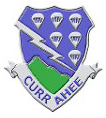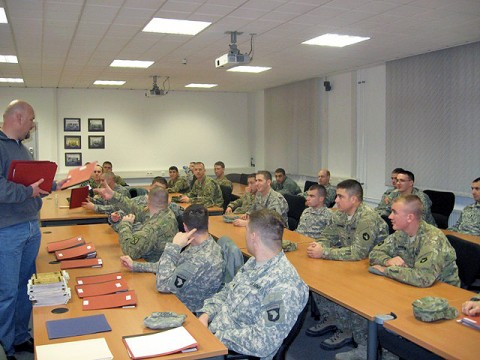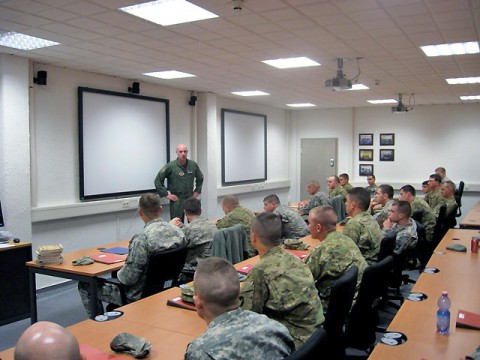Written by U.S. Army Sgt. Christina Sinders
Task Force Currahee Public Affairs Office

 Paktika Province, Afghanistan – Sixteen forward observers from 4th Brigade Combat Team, 101st Airborne Division, Task Force Currahee, travelled from Paktika Province mid-deployment to attend one of two, two-week classes at the Joint Fires School at Einsiedlerhof Air Base, Germany, to certify as Joint Fires Observers in January.
Paktika Province, Afghanistan – Sixteen forward observers from 4th Brigade Combat Team, 101st Airborne Division, Task Force Currahee, travelled from Paktika Province mid-deployment to attend one of two, two-week classes at the Joint Fires School at Einsiedlerhof Air Base, Germany, to certify as Joint Fires Observers in January.
“We deployed with (more than 50) JFOs in the BCT and that was not enough,” said U.S. Army Col. Sean M. Jenkins, commander of the 4th BCT, and native of Ridgefield, CT. “No element moves, flies, drives or walks without a JFO in the formation. They are that important.”

And that is where the JFO’s come in.
“The class teaches the FO’s to integrate close air support, close combat aviation and surface-to-surface fire support systems into one engagement,” said Schade. “The JFOs are also trained to communicate more specific and precise information to the (U.S. Air Force Joint Tactical Air Controllers).
“JFO’s are the eyes and ears of the JTACs on the battlefield so that one JTAC can manage multiple fights from the (Tactical Operations Center),” said Schade. “The ability to integrate every facet of air and surface support into one fight is crucial.”
They learned how to work with CCA, CAS, naval fire support, artillery support and operate the Precision Strike Suite-Special Operations Forces system, said Schade.
“The course packs two months of school into a two-week course,” said Schade. “Most of these FO’s were pulled straight out of combat to attend the course and were hit with a lot of new information, new subject matter and a totally new concept of controlling their battle space.”
To help prepare FOs for the JFO course, Jenkins instituted a brigade preparatory course called Joint Fires Observer-University in September 2009.
“JFO-U is a four-day course our brigade’s FOs go through before attending the JFO School,” said Schade. “It is designed to familiarize the Soldiers with the information and let them practice the simulations on the call-for-fire trainer.”

A call-for-fire trainer is a system designed to give students a two-dimensional view of a battlefield scenario while practicing calling for fire, and directing CCA, CAS and AWT in a hands-on application.
The preparatory course was held both at Fort Campbell, KY, before the brigade deployed and here in Paktika Province during the deployment.
Now, before any FO goes to JFO School, they go through JFO-U, said Schade. That way the FOs feel ready and are better prepared for the school.
Trained JFOs are a great tool and force multiplier; they can control many different types of air and ground assets all in one fight, according to Schade.
“The information and skills I learned in the class will be really useful,” said U.S. Army Spc. Dustin Watson, the Honor Graduate from the second JFO class and native of Tularosa, NM “Our missions always have CAS and (air weapons teams) covering us, and now I know how to utilize them better.”


